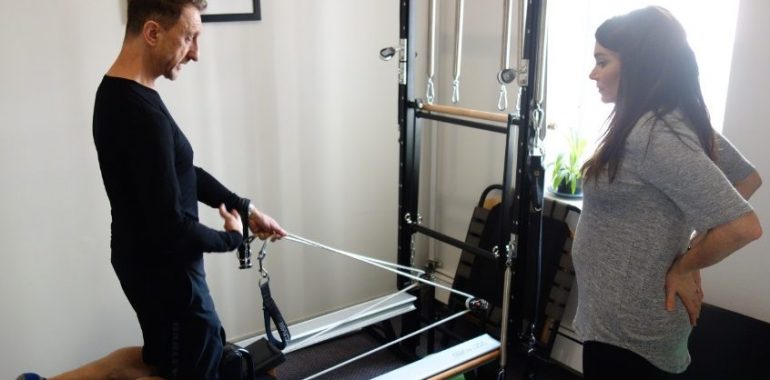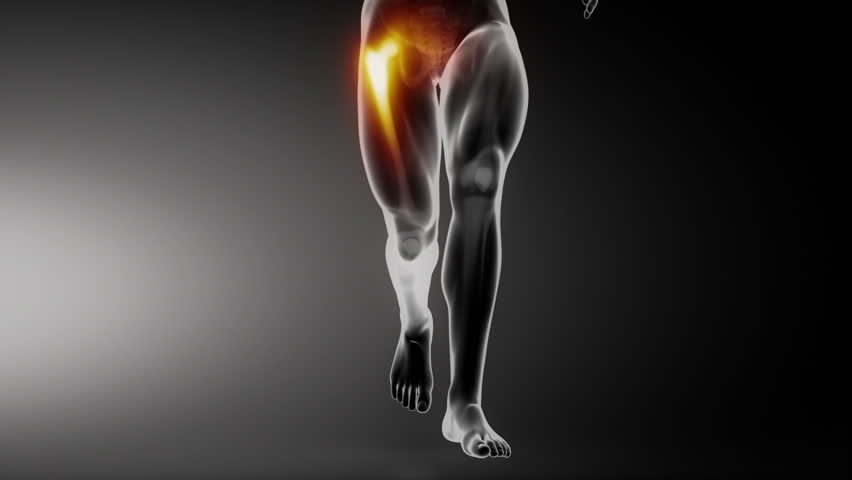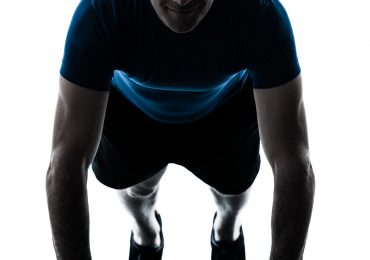Physiotherapy and Pilates for Pregnancy
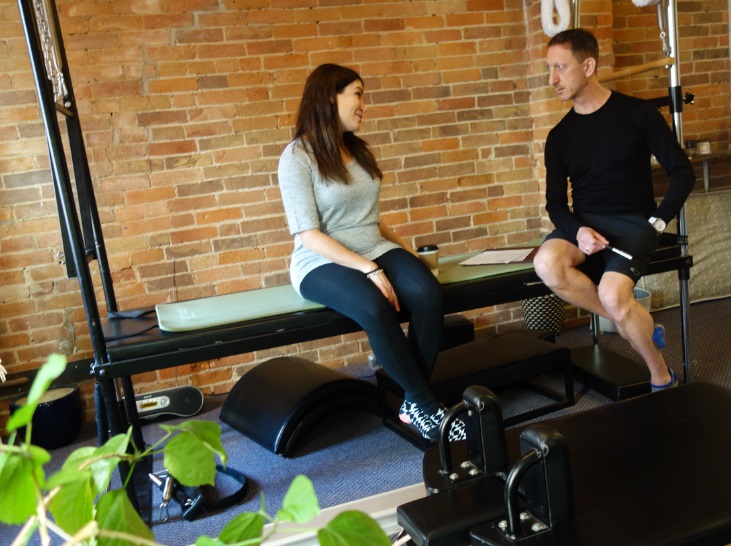
In early December 2016, a pregnant Karen N came in to see me for her initial assessment. Karen is thirty nine years old, and four and a half months pregnant with her first child. She has been given the okay from her family doctor to do some strengthening exercises. But should she be doing Pilates? Of course, the answer is yes.
Pilates is good exercise to reduce back pain during pregnancy.
Karen’s main concern is that she had back pain before getting pregnant and doesn’t want it to get any worse. She also isn’t sure what type of strengthening exercise to do? She wasn’t all that physically active before becoming pregnant, so is now really the right time to get fitness training? With these questions in mind Karen sought out a professional – she likes the idea of having a trained physiotherapist guiding her, listening to make sure she’s made the correct exercise choices. Karen is a PR consultant and wants to find a healthy balance between her work and exercise during and after pregnancy.
The entire first session is an Initial Assessment. The ‘Initial Assessment’ is when I take a full medical history and find out if there are any reasons NOT to proceed, and instead refer the patient back to her physician. I took 20 minutes to go through a full musculo-skeletal assessment to find out if there were any specific areas of concern. During this time I also provided some education on exercise in general during pregnancy. I used the Parmed-X For Pregnancy Screening Tool which helped me determine whether or not it’s even safe for Karen to participate in any exercise program. And together we made sure it was safe.
Parmed-X For Pregnancy Screening Tool
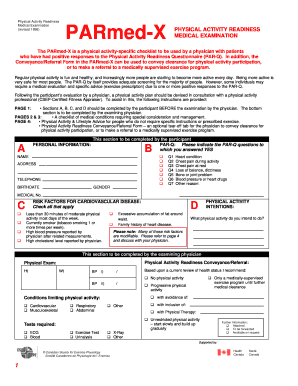 The Parmed-X is a Canadian screening tool, based on the clinical practice guidelines for exercise and pregnancy. It was devised by the Society of Obstetricians and Gynecologists of Canada and also the Canadian Society of Exercise Physiology. It has a lot of really useful guidance on both aerobic and strengthening exercise during pregnancy. It allows the physiotherapist to screen the patients for any contraindications and then explains the guidelines on how to incorporate aerobic and strengthening exercise. The guidelines use the FITT principle which is Frequency of exercise; Intensity; Time and lastly the Type of aerobic exercise. Here’s a link to The Parmed-X Screening Tool: Parmed-XPregnancy
The Parmed-X is a Canadian screening tool, based on the clinical practice guidelines for exercise and pregnancy. It was devised by the Society of Obstetricians and Gynecologists of Canada and also the Canadian Society of Exercise Physiology. It has a lot of really useful guidance on both aerobic and strengthening exercise during pregnancy. It allows the physiotherapist to screen the patients for any contraindications and then explains the guidelines on how to incorporate aerobic and strengthening exercise. The guidelines use the FITT principle which is Frequency of exercise; Intensity; Time and lastly the Type of aerobic exercise. Here’s a link to The Parmed-X Screening Tool: Parmed-XPregnancy
How aerobically active was the patient prior to pregnancy?
Even though Karen wasn’t that aerobically active prior to her pregnancy, she can still use an exercise program to reduce her back pain and alleviate some discomfort strengthening her lower back. My advice is to start in the second trimester once she has obtained clearance from her family doctor or obstetric provider. The guidelines actually go as far as suggesting there are more risks of NOT doing aerobic or strengthening exercise. These risks include: excessive maternal weight gain; risk of gestational diabetes; pregnancy induced hypertension; varicose veins and deep vein thrombosis; lower back pain and psychological issues.
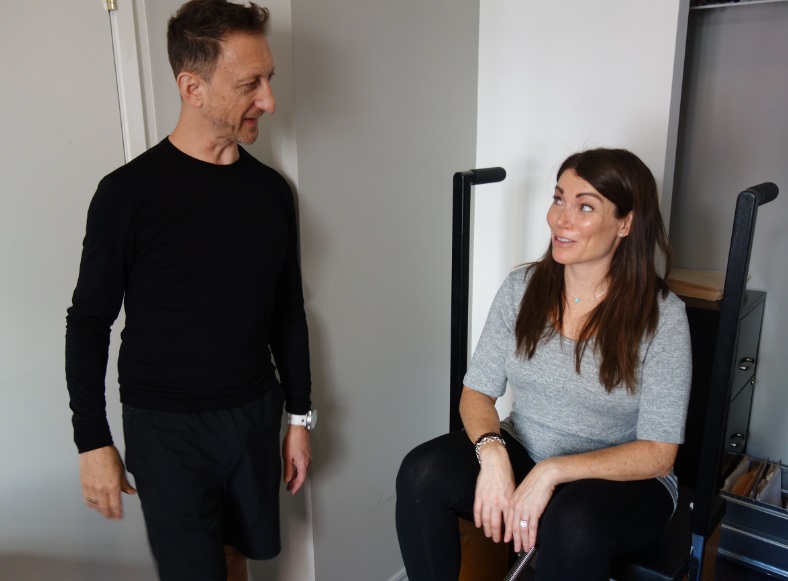
Karen’s main concern is her lower back, which is why she likes the combination of Physiotherapy and Pilates. She also wants to be able to recover quickly afterwards by becoming stronger and generally being in better shape.
Early in the session I was able to determine that Karen has some weakness and muscle control issues in her lower back and pelvis. I explained to her that even though her abdominal muscles will expand, she can still work on abdominal and pelvic floor strength. It’s important to do certain exercises that do not push the abdominals outwards, so abdominal curls are not recommended. I also explained how she needs to work on her lower back and gluteal muscles to prevent any sacroiliac joint problems.
Sacroiliac joint pain is a common pregnancy related condition.
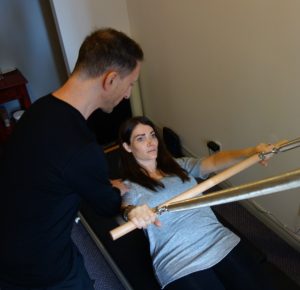
Strengthening her lower back and pelvis will help Karen carry the ever-increasing weight of the growing baby during pregnancy, and also after she gives birth.
Roll Down exercise using the bar and spring allows Karen to work her abdominals during a roll-back movement. This also mobilizes her lower back into flexion and extension and works the stabilizers of her spine. The springs partially support her body weight so she doesn’t strain her lower back or push her abdominals outwards.
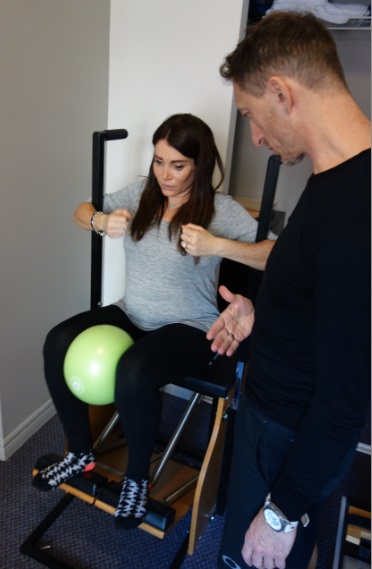
Pilates equipment is ideal for pregnancy strengthening programs. The equipment allows the body to be supported to take the stress of the joints, but provide the stimulus to the muscle groups. Karen is just over four months into her pregnancy so she should not do any exercises lying on her back. The Pilates equipment allows her to do a plethora of exercises in sitting, standing, lying on her side and in kneeling.
At one point during the assessment I invited Karen onto the Pilates Chair to work her hamstrings, gluteals, and adductors. I also showed her how to work her abdominals and pelvic floor muscles into the exercise. The springs are strong and she can really feel it in the hamstrings! Karen can do the leg work on the Pilates Chair, normally performed on the Pilates Reformer, but safer done while sitting during pregnancy.
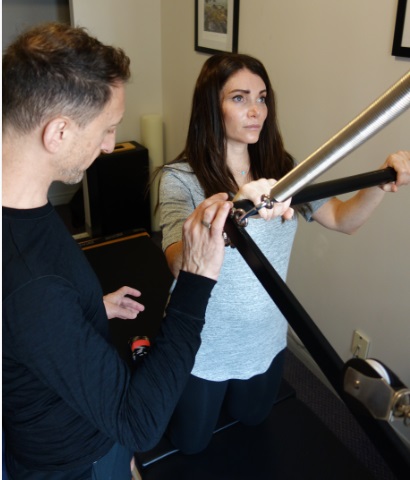
In the photo to the left, Karen is doing a back strengthening exercise using the trapeze bar with spring tension. This allows her to articulate through her spine in an all 4’s position. I cued her to segmentally roll though her spine, engaging her deep abdominal muscles and pelvic floor. This exercise will also strengthen her lower back muscles.
Karen and I spent the remaining part of the initial assessment going through some basic exercises. This yielded even more information about how she moves her body. Pilates is about quality of movement as well as strengthening.

The program will change as Karen progresses though her pregnancy and her body-weight ratio changes. She has been provided with a copy of the Parme-X so she can understand how to add the aerobic component to her exercise program.
Diet and exercise can reduce weight gain and improve health during pregnancy
A recent Cochrane review in 2015 shows that there is moderate evidence to support exercise for pregnancy-related lower back and pelvic pain. They also conclude that the studies are poor quality and hence difficult to draw conclusion from. In this situation as a physiotherapist we rely on our clinical reasoning and assess each patient individually. We look at the patient’s biomechanics, movement problems and muscle weaknesses.
Another Cochrane review in 2015 analyzed 65 trials to determine if exercise or diet, or both together, can reduce maternal weight gain. Exercises in these studies were moderate intensity and aerobic. They concluded there was high-quality evidence that diet or exercise interventions, or both, help to reduce excessive weight gain in pregnancy. Moderate intensity exercise may also reduce caesarean deliveries, especially with combined diet and exercise interventions, and maternal hypertension. In addition, the chances of having a baby over 4 kg and the chances of the newborn having breathing difficulties after birth may be reduced, especially in overweight and obese women. Moderate-intensity exercise appears to be an important part of weight-control strategies in pregnancy.
The aerobic exercise can be simple and non-impact such as walking, aqua aerobics and even spinning. The education piece on this is a huge benefit to women who just want to know what is effective and safe. If you have any questions about exercise and pregnancy please dont hesitate to contact us here a Pilates4Physio.

